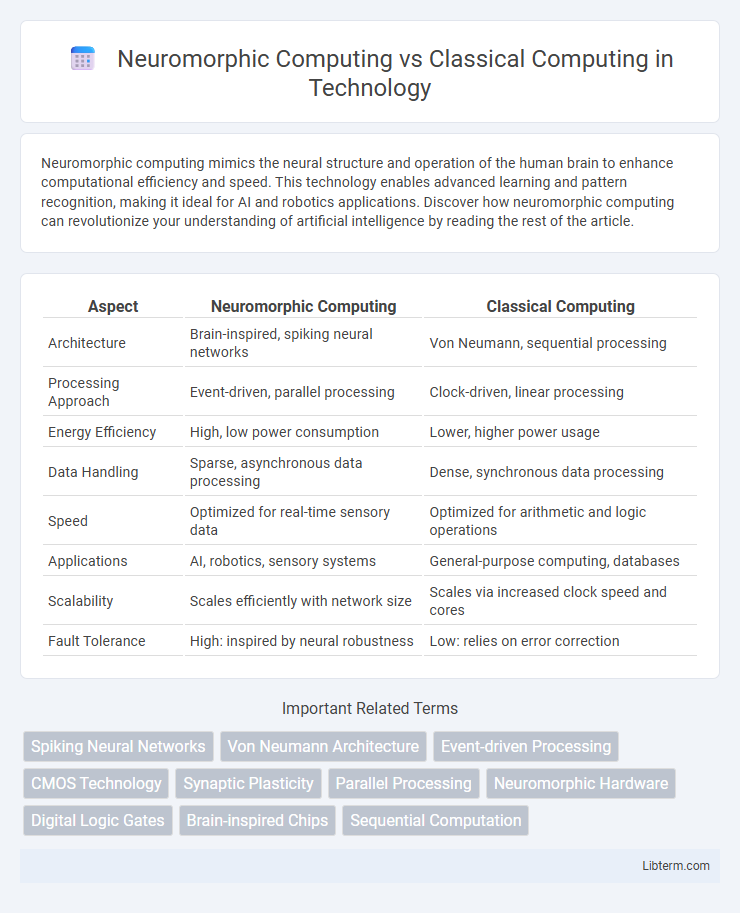Neuromorphic computing mimics the neural structure and operation of the human brain to enhance computational efficiency and speed. This technology enables advanced learning and pattern recognition, making it ideal for AI and robotics applications. Discover how neuromorphic computing can revolutionize your understanding of artificial intelligence by reading the rest of the article.
Table of Comparison
| Aspect | Neuromorphic Computing | Classical Computing |
|---|---|---|
| Architecture | Brain-inspired, spiking neural networks | Von Neumann, sequential processing |
| Processing Approach | Event-driven, parallel processing | Clock-driven, linear processing |
| Energy Efficiency | High, low power consumption | Lower, higher power usage |
| Data Handling | Sparse, asynchronous data processing | Dense, synchronous data processing |
| Speed | Optimized for real-time sensory data | Optimized for arithmetic and logic operations |
| Applications | AI, robotics, sensory systems | General-purpose computing, databases |
| Scalability | Scales efficiently with network size | Scales via increased clock speed and cores |
| Fault Tolerance | High: inspired by neural robustness | Low: relies on error correction |
Introduction to Neuromorphic and Classical Computing
Neuromorphic computing mimics the architecture and dynamics of the human brain using spiking neural networks and specialized hardware, enabling efficient parallel processing and adaptive learning. Classical computing relies on the von Neumann architecture with sequential processing using binary logic and separate memory and processing units, leading to bottlenecks in speed and energy efficiency. Neuromorphic systems excel in pattern recognition and real-time sensory processing, whereas classical computers dominate in precision and arithmetic computations.
Core Principles of Neuromorphic Computing
Neuromorphic computing mimics the architecture and dynamics of the human brain using spiking neural networks, enabling event-driven processing and massive parallelism for energy-efficient computation. Unlike classical computing's sequential and binary logic systems, neuromorphic systems implement neurons and synapses as physical components to process information through spike timing and synaptic plasticity. This core principle supports adaptive learning and real-time processing, critical for applications in artificial intelligence and sensory data interpretation.
Fundamentals of Classical Computing
Classical computing relies on binary logic and von Neumann architecture, utilizing sequential processing through transistors to perform calculations and store data in memory units. It processes information using deterministic algorithms and discrete clock cycles, enabling precise and predictable computation. The fundamental operations of classical computers are based on Boolean algebra and are optimized for general-purpose tasks with established programming paradigms.
Architecture Differences: Brain-Inspired vs. Conventional Design
Neuromorphic computing employs brain-inspired architectures featuring spiking neurons and synapses designed to mimic the parallelism and adaptability of biological neural networks, enabling efficient processing of sensory and cognitive tasks. Classical computing relies on Von Neumann architecture, with separate processing and memory units executing sequential instructions, which limits parallelism and increases latency. The fundamental shift from digital, clock-driven circuits in classical systems to event-driven, analog or mixed-signal circuits in neuromorphic designs results in distinct energy efficiency and real-time learning capabilities.
Processing Speed and Efficiency Comparison
Neuromorphic computing leverages brain-inspired architectures to achieve parallel processing, resulting in significantly faster data throughput and lower latency compared to classical computing's sequential processing model. Energy efficiency in neuromorphic systems can be up to 1000 times greater than traditional CPUs and GPUs due to spike-based information encoding and asynchronous event-driven operation. While classical computers excel in precision tasks, neuromorphic chips offer superior performance for pattern recognition and sensory data processing with minimal power consumption.
Power Consumption and Energy Efficiency
Neuromorphic computing mimics the human brain's neural architecture, significantly reducing power consumption by using event-driven processing and asynchronous signaling, which contrasts with the continuous, clock-driven operation of classical computing. This approach enables neuromorphic systems to achieve higher energy efficiency, particularly in tasks involving pattern recognition and sensory data processing. Classical computing relies on fixed instruction cycles and often requires more energy due to the constant switching and data shuttling between memory and processors.
Real-World Applications: Neuromorphic vs. Classical
Neuromorphic computing excels in real-time sensory processing and adaptive learning applications such as robotics, autonomous vehicles, and brain-machine interfaces, leveraging its architecture inspired by neural networks for energy-efficient pattern recognition. Classical computing remains dominant in precise numerical calculations, large-scale data processing, and established software ecosystems crucial for traditional business applications, financial modeling, and scientific simulations. The integration of neuromorphic chips in edge devices complements classical systems by enabling low-latency, low-power intelligence where conventional computing faces power and speed limitations.
Scalability and Flexibility Considerations
Neuromorphic computing mimics neural architectures, offering superior scalability by efficiently processing parallel, spiking data streams compared to classical computing's sequential operations. Its flexibility allows dynamic adaptation to evolving tasks and real-time learning, contrasting classical systems optimized for fixed algorithms and rigid data structures. Scalability in neuromorphic hardware enables seamless expansion in neuron and synapse counts, promoting energy-efficient computation in complex AI workloads.
Challenges and Future Prospects
Neuromorphic computing faces significant challenges such as hardware complexity, scalability issues, and energy-efficient spike-based communication, contrasting with classical computing's well-established silicon-based architecture and binary processing. Overcoming nanoscale device variability and developing advanced algorithms tailored for spiking neural networks are critical for neuromorphic systems to achieve practical applications in AI and edge computing. Future prospects include integrating neuromorphic chips with classical processors to enhance cognitive computing capabilities, enabling low-power, real-time data processing for autonomous systems and big data analytics.
Conclusion: Choosing the Right Computing Paradigm
Neuromorphic computing excels in pattern recognition and energy efficiency by mimicking brain-like neural architectures, making it ideal for AI and sensory data processing. Classical computing remains dominant in general-purpose, high-precision tasks due to its well-established binary logic and vast software ecosystem. Selecting the right paradigm depends on application requirements: neuromorphic systems for adaptive, real-time learning, and classical computing for reliable, precise computations.
Neuromorphic Computing Infographic

 libterm.com
libterm.com